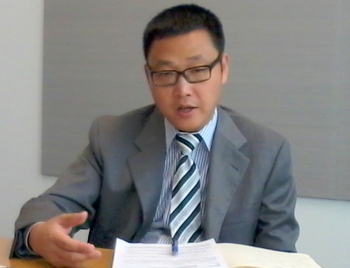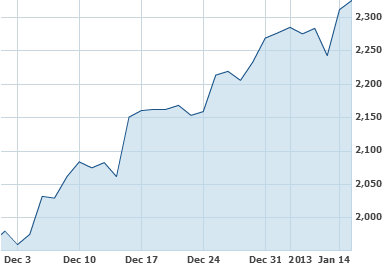Main reference: Story in Securities Daily
DON'T LOOK NOW, but Chinese shares are up around 20% since December.
A listed brokerage points to eight reasons why the recent bullishness is still alive and kicking.

The benchmark Shanghai Composite Index – chief tracker of China’s A- and B-shares listed on the country’s two bourses in Shanghai and Shenzhen – is trading at levels not seen in months and has risen by double digits since the beginning of last month.
In addition, daily trading volume is at a 10-month high.
The new leadership in Beijing is firmly in place and most GDP forecasts for 2013 are noticeably more upbeat than the performance seen in 2012.
So with all these positives in place, will shareholders in China quit while they’re ahead, or stick it out and wait for even better returns as the new year progresses?
Soochow Securities says that macroeconomic data is providing an updraft for A-shares heading into the year 2013, including improvements in the PPI (the chief barometer of manufacturing vitality), a stable CPI, expectations of a more robust GDP and an export recovery on the horizon.
The Shanghai-listed brokerage, based in the eastern city of Suzhou, also said that the China Securities Regulatory Commission (CSRC) – the country’s equity market watchdog – is showing more openness to foreign involvement in the PRC’s bourses, which will help boost market liquidity and trading volume.
CSRC Chairman Guo Shuqing said on Monday that investment quotas for the relatively new Renminbi Qualified Foreign Institutional Investment (RQFII) program, along with the decade-old Qualified Foreign Institutional Investment (QFII) scheme, would be allowed to expand by up to 10 times their current values.
This comes on the heels of news that China’s market regulator issued almost 16 billion usd in investment quotas to overseas institutional investors last year – a sum on par with the total amount awarded between 2005-2011.
The QFII program, instituted in 2003, has to-date hit some 37 billion usd in total quotas – all targeting China’s long-sheltered A-shares.

The RQFII initiative, launched just over a year ago, was originally allotted a total quota of 20 billion yuan – a sum that was quickly used up and then hiked to 70 billion.
The scheme allows foreign investors to buy into PRC-listed stocks using offshore renminbi accounts.
Soochow Securities said it is also sanguine on China shares going forward because the average P/E ratio for all A-shares is at a historic low of just 14.16 times.
This not only provides a sense of security to newcomers, but offers a great range of potential upside across a wide range of sectors and themes.
Fourthly, Soochow Securities said the new administration in Beijing is giving every indication that it will pursue a pro-active, pro-growth” policy covering a broad swath of industries, particularly energy, transportation/communications, national security and construction.
These are all very capital and material-intensive sectors and should be a major stimulus for cement, iron & steel, heavy machinery and other industries involved.
Also, Soochow said things are also looking up outside of China, and the global economy is apparently on the right track after a report by BofA Merrill Lynch this week saying investors worldwide have begun the new year with an upbeat sentiment, with 2013 expected to see more funds allocated to shares at levels not seen since early 2011.
Furthermore, the report found global economic outlook confidence at its highest point in nearly three years.
Sixth, Soochow said there is little near-term possibility of the IPO conduit being suddenly opened wide by the market regulator.
This will prevent a tightening-up of liquidity in the capital markets, while keeping capital-hungry A-shares from withering on the vine.
In addition, the risk-reward ratio for A-shares is currently at very attractive levels, especially with regard to the risk premium vis-à-vis the potential returns.
This not only attracts newcomers to the market, but encourages more long-term positions by existing shareholders.
Finally, Soochow said that as the economy improves, underground lending will cease to be an attractive option as legitimate bank borrowing becomes more viable, all of which will help stabilize capital flows into the market and temper speculation and the sharp fluctuations that often come in its wake.
See also:
E FUND: Betting On A China Recovery
ZULAUF: China Shares Could Jump 30% In H1
SANGUINE SNAKE? Over 70% Of Shareholders Upbeat On 2013
China On Verge Of Historic Bull Run?
XMAS Celebration And Shopping Take Off In China




